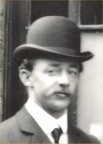Albert Edwin Roberts
| Albert Edwin Roberts | |
|---|---|
 | |
| Narození | 26. února 1878 Birmingham |
| Úmrtí | 24. července 1964 (ve věku 86 let) Ipswich |
| Povolání | fotograf |
| Některá data mohou pocházet z datové položky. | |
Albert Edwin Roberts nebo také Bert Roberts (26. února 1878, Birmingham – 24. července 1964, Ipswich, Queensland) byl australský fotograf a kouč. Renesanční muž, který se zajímal širokým rozsahem předmětů, a pořídil mnoho fotografií každodenního života kolem Ipswiche v Queenslandu na počátku 20. století.[1][2]
Život a dílo
Od začátku 20. století tvořil svá díla především v queenslandském Ipswichi. Více než tisíc skleněných desek z jeho díla je součástí sbírky A E "Bert" Roberts plate glass photo collection, kterou vlastní Queenslandské Muzeum.
Galerie
Odkazy
Reference
- ↑ Ipswich Photographic Society [online]. [cit. 2018-04-16]. Dostupné v archivu pořízeném z originálu dne 17 April 2018. (anglicky)
- ↑ BUCHANAN, Robyn. George Roberts: Motor cars and aeroplanes [online]. Ipswich City Council, 1995 [cit. 2019-04-04]. Dostupné v archivu pořízeném dne 2016-04-08. (anglicky)
Související články
Externí odkazy
 Obrázky, zvuky či videa k tématu Albert Edwin Roberts na Wikimedia Commons
Obrázky, zvuky či videa k tématu Albert Edwin Roberts na Wikimedia Commons
Média použitá na této stránce
Women Enjoying Tea, Dressing Up and Good Company
Dressed up in homage to Gilbert and Sullivan perhaps, or just enjoying a Japanese tea party, these young ladies enjoyed broad cultural horizons, on the verandah of a Queenslander (house).
Queensland Museum holds over 1000 of Bert Roberts' plate glass negatives and prints from the era.A E (Bert) Roberts was a coachbuilder by trade in Ipswich (Queensland), but a true renaissance man at heart. Bert’s interests included geology, music, Aboriginal culture, nature and the modern technology of the early 1900s. His broad interests and love of life are reflected in the many photographs he took.
Queensland Museum holds over 1000 of Bert Roberts’ plate glass negatives and prints from the era.
Additional Information
The Roberts family records indicate that Albert Edward Roberts (Senior) was born in Birmingham, England, in 1855. He had two sons: Albert Edwin Roberts (Junior) (known as Bert) was also born in Birmingham in 1878, and Leo, a younger brother sometime later (date unknown). The Roberts family migrated to Queensland (Australia) in 1881.
Bert was a prolific photographer whose work is being shared on Wiki Commons. Bert married Florence Sarah Roberts in 1907. They had four children who led long and interesting lives: Norman (1908), George (1909), Florence Ivy (1912) and Don (John Edwin) 1916. A fifth child, Trevor Moreton (1922), did not survive infancy.
A Wikipedia article is currently being researched and written about the Roberts family by a Wiki member. One of the primary sources of evidence is an oral history interview conducted in 1995 with George Roberts, who was Bert’s second son.Fashionable Ladies of the Day
Large hats and long dresses were all the fashion for women in the 1900s. Ankles were rarely seen. During the War limits on materials, the more sombre mood, and increasing numbers of women working led to more practical, less frilly and flamboyant clothing.
Queensland Museum holds over 1000 of Bert Roberts' plate glass negatives and prints from the era.
Historical Enquiry Questions
Study the clothes the five women are wearing. Use the Wikimedia magnifying glass to highlight the dress designs and motifs.
1. Why do you think this photograph was taken?
2. Where do you think the women might be going?
3. During what era do you think this photograph was taken?
4. Who do you think these women might be?
5. What rules about dress and fashion do you think these women followed?
6. Why do you think the girl is wearing a short dress, while the women are wearing longer dresses?
7. Make a list of the similarities and differences between the clothes worn today and those in the photograph
8. Describe the hairstyles of the four older women.Holms Brothers baker’s van
Every street in Australian towns was served by delivery vehicles such as this baker’s van. Most families did not own a buggy to go shopping, so milkmen, butchers, bakers, fruiterers, fish mongers all delivered door-to-door. This van was built in the AE Roberts workshop and photographed in the street outside.
Queensland Museum holds over 1000 of Bert Roberts' plate glass negatives and prints from the era.The Last Drive
A E Roberts Carriage Works made beautifully finished vehicles such as this hearse. The hearse, the driver and the horses were immaculately turned out. Sadly, most people would ride in a salubrious vehicle only once, and it was a ride they would not remember.
Queensland Museum holds over 1000 of Bert Roberts' plate glass negatives and prints from the era.Bert Roberts (Junior) with his children: Norm, George and Ivy.
Little boys were often dressed in sailor style outfits and had ringlets in their hair. The photo was taken around 1912 at the family home in York Street Ipswich. Bert built the house in 1907.
Bert married Florence Sarah Roberts, in 1907. They had four surviving children: Norman (1908), George (1909), Florence Ivy (1912) and Don (John Edwin) 1916.
Queensland Museum holds over 1000 of Bert Roberts' plate glass negatives and prints from the era.Boys at the beach.
The scene could be at a beach or perhaps a river bank. The boys are enjoying posing for the camera. Segregated swimming was still in vogue until around 1910, but that did not stop beach holidays for the boys. Women in bathing costumes were a much rarer sight in the era.
Queensland Museum holds over 1000 of Bert Roberts' plate glass negatives and prints from the era.











